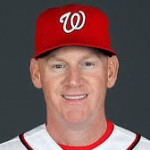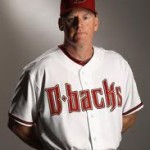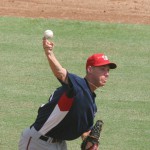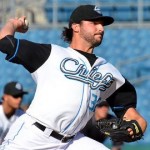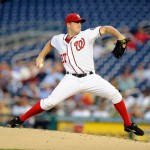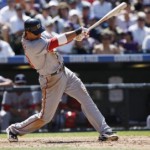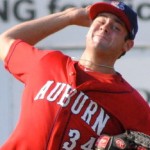Washington Post columnist Tom Boswell must be in heaven: he’s at Spring Training, in 80 degree weather, talking baseball. Here’s his 2/18/14 WP chat edition and how i’d have answered his baseball questions. He did an extra long session, doing an hour and then coming back for even more questions, so this is a huge post.
Q: Which Nat is most and least likely to benefit from Matt Williams’ detail-oriented approach?
A: I’ll take the easy way out on this one: I’ll say that the rookies are most likely to benefit and the veterans are least-likely. But that’s probably not very fair because it assumes that our vets will automatically have a hard time adjusting to a new voice. In reality, Matt Williams‘ pedigree as a player is going to shut just about any veteran up; name one player on this team who has accomplished anything close to what Williams did as a player? I mean, we’re talking about a guy with multiple All Star appearances, multiple Gold Gloves, multiple Silver Sluggers, a couple near MVP seasons, more than 200 post-season at-bats spread across 5 post-season trips, three trips to the World Series and one ring. He also played in two specific games that are both counted among the best games of the last 50 years (Game 7 of the 1997 World Series and 2001’s Game 7 of the World Series).
That’s a heck of a lot of accomplishments. Who in their right mind is looking him in the fact and doubting his wisdom about anything?
Boswell points out a number of guys who are “introverts” who like the structure, mentions Rafael Soriano as a possible problem child … but then also notes Soriano lost a ton of weight and is playing for a contract, so he doesn’t expect any issues. Fair enough.
Q: Where can I get good details on the Nats spring training schedules in Viera?
A: CSN’s Mark Zuckerman posts a great intro-to-spring training on his Natsinsider.com blog each year. Here’s parts 1 and 2, focusing on the Nats baseball Complex and the Town of Viera. Boswell speaks highly of watching bullpen sessions. Can’t blame him; man I want to do Spring Training sometime!
Q: What does the Yankees signing of Masahiro Tanaka do for the Yankees season?
A: Not much in my opinion. Despite Tanaka’s pedigree and $175M paycheck, he’s being touted by his own team as a “#3 starter.” That’s a heck of a lot of money for a #3 starter. Now in reality scouts liken him to a young Dan Haren (in terms of his repertoire), but he’s still not nearly in the same Ace class as the most recent Japanese import Yu Darvish. Plus he’s got to deal with the inevitable adjustment to this country, a new language, 10,000 obnoxious NY beat reporters, the food, the city, and that pesky 4-days of rest schedule we have here for our starters.
As for the Yankees chances in 2014 in general, check out their current depth chart: Their rotation is set to be Sabathia (coming off an awful year), 40-yr old Kuroda, Tanaka, Ivan Nova and David Phelps. Does that sound like a 95-win rotation? Here’s their infield: Mark Teixeira (15 games last year), Brian Roberts (77 games last year), Derek Jeter (17 games last year), and Eduardo Nunez (90 games last year). Does that infield inspire confidence? What makes anyone think that infield is lasting even a quarter of the season without a major injury? Plus, Buster Olney or Jayson Stark recently mentioned this factoid: “No team has ever in the history of the game had a winning season starting a shortstop as old as Jeter.” Yes the Yankees made some significant signings (Beltran, Ellsbury, McCann). But I don’t think its enough to make up for what’s going to happen to their infield. I think years of overpaying for FAs and being unlucky in their player development has caught up with the Yankees in a big way and they’ll be lucky to be a .500 team this year. Boswell points out that PECOTA has them as 82-80. And then he drops a scary subtle hint saying that Ian Desmond has already declined an $85M deal and may have his sights on becoming the next Yankees long-term shortstop. Ouch. Thankfully the timing doesn’t quite work out; Jeter retires after this year and the Nats have Desmond locked up for two seasons.
Q: Can you go into the stadium and see the view from your seats before committing to a Season Ticket?
A: No idea, but I’d bet the answer is yes. We could do that before, you know back when I was a season ticket holder, pre Nats stadium, pre kids, pre getting-royally-screwed-in-the-new-stadium-relocation game. Boswell assumes yes, and posts an answer confirming it from another fan later on who did exactly this.
Q: Why is the name Redskins such a hotbutton while the Braves gets almost no press?
A: (I couldn’t resist this question even if not entirely about Baseball): Probably because one name is a slur and the other is just a noun. In a politically correct world no person-indicating moniker would ever be used as a team nickname … but then again you can get rather ridiculous (is “Padre” and the drawing of a priest with a goofy smile swinging a bat offensive to the clergy? I’m of Irish descent; what if I said that the Notre Dame “Fighting Irish” is offensive to me because of my culture?). Plus, frankly, I don’t get why little Danny Snyder won’t just frigging change the name; I mean, how many gazillions of dollars of new merchandise sales would he get if he re-branded the team? Why is he so obstinate about this issue? Every time he posts some dumb letter defending the name it makes him look more and more like a little rich whiny fan-boy who grew up loving the team despite being too sickly to actually play, and now he’s clinging to an iconic symbol of his youth. As if it was a ratty security blanket. Boswell talks about cultural change and social progress and hints that he’s going to post his official opinion on the matter soon.
Q: Has Jeter’s retirement caused TOO much media attention?
A: Honestly, I don’t feel like it has; at least not as much as the questioner, who whined about all the coverage and news items related to Jeter. Perhaps its because he’s gone up against the Olympics and NBC’s force-fed human interest coverage machine that I havn’t noticed.
Olympics Rant/Tangent: Seriously; I thought I had seen it all with NBC’s ridiculous coverage over the years of figure skaters as “athletes” … now the coverage of these silly snowboarders has surpassed it. I’m sorry; if your “sport” requires judges who take into consideration your “style” or your “costume,” then it isn’t a sport. “Team skating?” “Ice Dancing?” Why not just have a frigging spinning contest or see who can coast the longest on one skate or some other useless reason to award a few more gold medals? In my opinion, if there isn’t a score or a race to a finish line or one man versus another in a contest … you’re not a sport. Nothing against figure skaters specifically; what they do is amazing, requires elegance and strength and years of training. But so does Ballet; why is one an olympic sport and the other a performance art? All those cirque-de-soleil performers? Why isn’t that an olympic sport too?
Tangent/Rant off.
I think we’ll all be pretty frigging sick of Derek Jeter once August and September rolls-around. Yeah he’s a great player, first ballot hall of famer. But so are about 20-25 other guys playing right now. I agree with the questioner’s rant about the over-coverage of all things Yankees. Boswell points out that Jeter’s career WAR is one spot above Bobby Grich, so as to temper some expectations. That’s harsh; even I recognize his importance to the game as a surpassing point than just whittling down all his accomplishments to one (dubious) number.
Q: What is Livan Hernandez’s role on this team?
A: Whatever it is, I think its friggin awesome that he’s in Spring Training representing the Nats. Kudos to whoever reached out and got him to come help out. Livan Hernandez may have played all over the majors (9 teams in 17 seasons; that’s tough to do when you’re not a left-handed reliever) but he played the most of it with our franchise. Boswell’s quoting of Drew Storen‘s description of Livan’s role is awesome: “His job is life-coach, bleep-talker and being Livo.” He also notes that Livan can provide some fielding and instruction on holding runners, a sore spot for several Nats starters.
Q: How is Christian Garcia looking so far? Any chance that he goes north with the club?
A: All reports list Christian Garcia as (finally) healthy. But its telling that the team is already specifically pointing out that “he’s made it further than he did last year.” It seems like his fragility is almost a running joke on the team now. Chances of breaking into the 7-man bullpen? Remote unless there’s injuries. But if he goes to AAA and pitches lights out, he’ll be first guy back. If he stays healthy (four words that should be attached to every single sentence ever written about Garcia). Boswell says that if he’s healthy, he’s on the team. I have a very hard time believing that; who makes way? Not Soriano, Storen, Clippard or Stammen. Not Blevins. Ohlendorf? Roark? Roark’s numbers last fall were *better* than anything Garcia did in 2012 and in 4 times the innings. Ohlendorf isn’t being paid north of $1M to screw around in upstate New York. And, none of this takes into account the statements from Williams about liking to have two lefties in the bullpen… If it were me, I’d want to see Garcia pitch at least a month straight without hurting something on his person.
Q: How would you grade Rizzo’s off-season?
A: Pretty frigging good. Fister: fantastic acquisition. McLouth; not too bad, should help. Lobaton: looking better and better, considering the pedigree i’m hearing about the two guys thrown into the deal (Vettleson and Rivero). I don’t think his lack of acquiring a better lefty will hurt; Sammy Solis is impressing and could contribute immediately, newly acquired Rivero apparently has some stuff, and there’s still the likes of Cedeno and a couple other AAA guys who we could use. Boswell says A- … and then tells a tid-bit about the Grant Balfour deal that fell through.
Q: Why are the Nats pitchers so bad at holding runners on? Is this something they’re working on this Spring
A: Why? beats me. Maybe a better defensive catcher will help in that category. They definitely seem to be working on it this spring as noted in the above Livo question. Boswell doesn’t really answer the question but then uses this question as a segue into talking about Williams’ anger issues. Random.
Q: If Ryan Zimmerman is going to play some first base … what the heck is Tyler Moore going to do?
A: A decent question, but which assumes that Tyler Moore is anything other than a bench bat. And it assumes that Adam LaRoche is going to platoon. I know plenty in the blogosphere want that to happen … but this is a contract year, and the last time couple times LaRoche faced a contract year he played pretty durn good. Meanwhile, Moore seems like the kind of player who could use a change of scenery and a trade to a team with more playing time. Boswell likes his swing.
Q: Is team improvement correlation or causation to a hitting coach change, like what happened last year with Eckstein’s firing?
A: You ask me, i’d say its correlation/coincidence. It isn’t the hitting coach facing 95 mph fastballs. But I’m no professional. Boswell can’t figure it out either.
Q: Did they really need another catcher when they had both two young options and Synder as a proven vet? Why waste a pitching prospect with a high upside for a backup catcher who can’t throw out runners, already a major problem. Did Rizzo get taken by the Rays?
A: Sounds to me like this question-er is overvaluing the potential contributions of our catching prospects Sandy Leon and Jhonatan Solano, is incredibly overvaluing what Chris Snyder still brings to the table, and is overvaluing Nathan Karns and what is ceiling seems to realistically be. Oh, and he’s undervaluing the prospects we got in return (both of which are in our top 14 according to mlbdraftinsider.com’s recent post). I like the move, it fixes a hole for the team and gives a couple of prospects to shore up a thinned system, all for a guy who I think we all liked in Karns but who likely faces a ceiling of a reliever. Boswell notes the need for a “real” backup catcher and notes that the team traded from depth.
Q: Have the Braves taken a step back this offseason and are really counting on BJ Upton to do anything on offense this year?
A: Yes and yes. McCann is a huge loss. Tim Hudson may not “seem” like a loss given the Braves pitching depth, but he was their opening day starter in 2013 and was their bulldog staff leader (if not an “ace” in the literal sense of the word). They also let go Paul Maholm, who gave them a ton of decent innings last year. They’re depending on Brandon Beachy to come back healthy and on the rest of their young rotation to contribute. Otherwise they did little this off-season other than extending a couple of guys. As far as BJ Upton, what choice do they have but to run him out day after day at this point? Same as Dan Uggla: those two guys are getting paid a ton of money and will be given every chance to prove themselves. Boswell agrees.
Q: How often have you seen baseball players take a hometown discount?
A: Not very often: Roy Halladay took a bit less so he could play for Philly … because their spring training complex is in the same town as his full-time home. Hard to think of obvious other players off-hand. The asker questioned whether Jordan Zimmermann would consider less money to play for his “hometown” Brewers … without really considering the fact that Milwaukee is a cheap-skate franchise and will *never* come close to paying the 9-figure deal that Zimmermann probably earns in two years’ time. Boswell doesn’t really answer the original question, just notes that so far our FA players are going for the money.
Q: In your opinion, who will end up being the fifth starter? Detwiler, Roark, or Jordan?
A: Ross Emery Detwiler, for the same reasons I pointed out in my 2014 Staff Projections post in late december. Quoting myself from that post:
Why am I predicting Detwiler will win the rotation spot? Partly because of options (Detwiler has none while Roark, Ohlendorf and Jordan all do), but partly because I’ve sort of come back around on him after looking more closely at his 2013 season. He had a decent to good 2012; he posted a 118 ERA+ and even if his advanced FIP/SIERA didn’t indicate he was quite that good, he was still more than a servicable 5th starter. Then in his first seven 2013 starts he was also very good (he had a 2.53 ERA in his first 7 starts and 42 2/3 innings … he got hurt in his 8th start). The rest of his season was a mess, with him fighting injury and ballooning his seasonal ERA from 2.53 to more than 4.00 in five more starts. If he comes back healthy to start 2014, why wouldn’t we expect more of the same performance that he had at the start of 2013? For these reasons, I think Detwiler breaks camp as the 5th starter.
I like Tanner Roark and feel the team is going to find a way for him to be in the MLB bullpen. I also now believe Taylor Jordan‘s off-season ankle injury will give the team an excuse to keep him in the minors a bit to season him up and maybe even keep some innings off his arm. So it’ll be Detwiler until he either falters or gets hurt again. At least we have a ton of options this year to cover for a starter injury.
Boswell says Detwiler as well but writes a ton on othe other guys, including a glowing talk about Roark. And he throws in this tidbit: Detroit asked for Jordan and Robbie Ray before settling for Ray and spare parts. Interesting.
Q: What’s your read on how the last two bullpen spots play out?
A: Also borrowing from my Dec 2013 post, I’ll go with Ohlendorf and Roark. Ohlendorf as the long-man, spot starter rubber arm guy. Roark with the hope he continues his magical run of exceptional command and fearless relief. I know that only leaves on lefty out there, and leaves guys like Ryan Mattheus and Christian Garcia in AAA. Hey, I could be wrong. Boswell doesn’t seem to guess.
Q: Do you think the coaches will let Espi continue to be a switch hitter or keep him as a lefty hitter only?
A: I hope you mean righty hitter only; he is a career .220 lefty hitter but .262 righty. If I was the Nats brass, i’d try him as a righty-only guy. But by all accounts Danny Espinosa is a bit stubborn and may not be open to limiting a unique skill that he may continue to think distinguishes himself from other competitors. I continue to wonder just how hurt he was last year … as others have said, it isn’t like Espinosa suddenly forgot how to hit. Yes he was always somewhat limited as a player, but 20-homer capable middle infielders don’t grow on trees. Boswell says the team isn’t messing with Espinosa, and that they want to see what he can do in 2014. Fair enough.
Q: Are you worried about the power (or lack thereof) in the Nats lineup?
A: Not really. The capability is there across the lineup. Zimmerman has hit 30. So has LaRoche. Desmond has hit 20. So has Espinosa. Ramos has 20+ homer capability if he’s healthy. Werth is good for 25 and has hit 30+ before. And none of this talks about our best power hitter Harper and what he can do. Basically the team is a whole bunch of guys with 20 homer capability. The Nats were T-3th in the NL in homers last year as a team (trailing two teams in offensive parks) and should improve in this category with a healthy Harper. Boswell just talks about Ramos’ stats extrapolated to a full season.
Q: Is praise of Williams’ approach tacit criticism of Davey Johnson’s?
A: Yeah probably. That’s why you change managers; to change the message. I’m not going to disparage Davey Johnson too much here other than to say what i’ve said before; the team needed a new voice. Boswell points out that Johnson’s 2012 job was fantastic and that there’s “different jockeys for different horses.” I like that analogy.
One last point: there was a question about MASN that Boswell went off on and gave some tidbits, including a shot at Bud Selig. Its worth the read; click on the chat link and head to the bottom.
